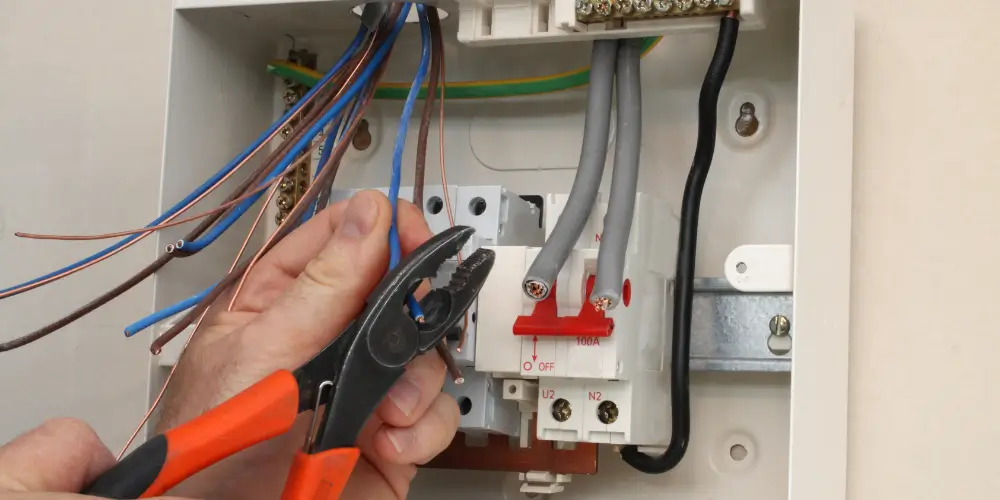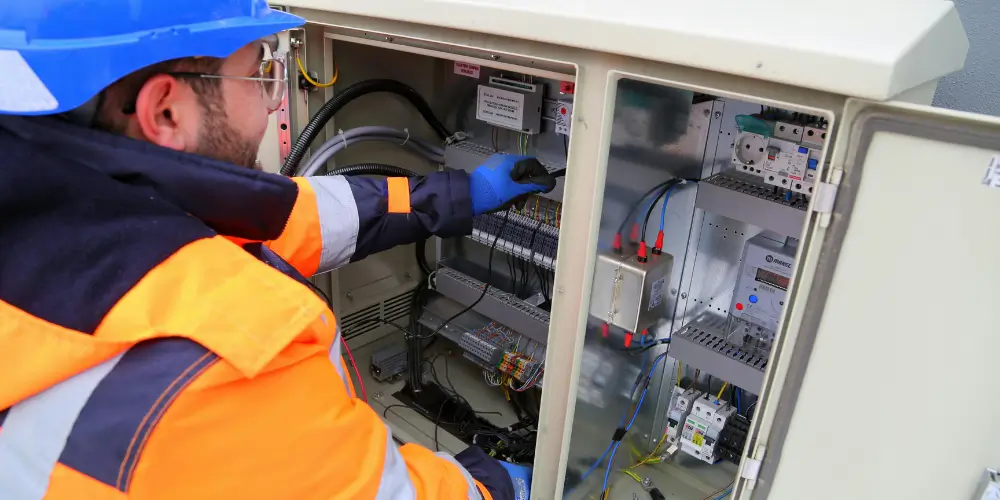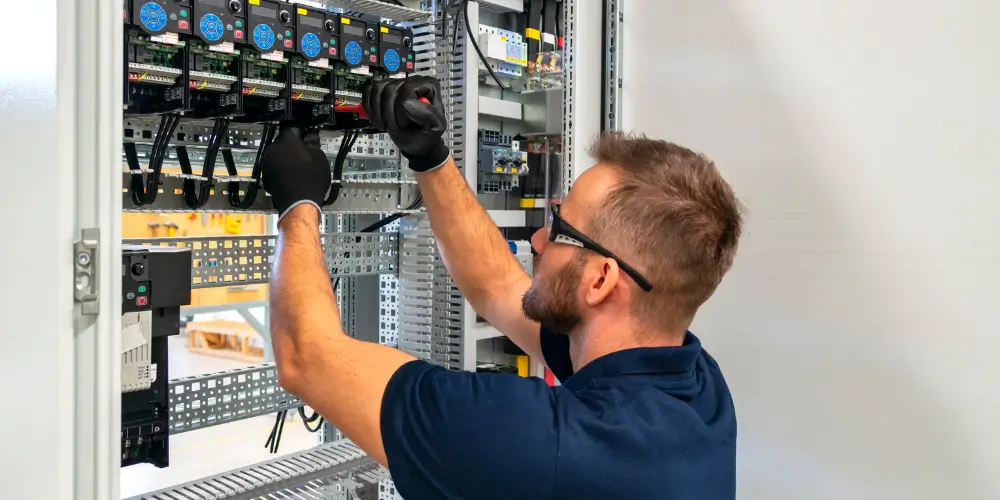Replacing a consumer unit typically involves various cost factors, including the type of unit, such as dual RCD, split-load, or RCBO, and the complexity of the installation. We’ll consider the need for potential upgrades like earthing and additional circuits, which influence the overall expenses. Costs can also vary by region, but on average, you’re looking at approximately £480 to £1500 in London. However, prices can go higher based on specific requirements and unforeseen issues. Experienced electricians should carry out this process to guarantee safety and compliance with current electrical regulations. We’re here to guide you through understanding the nuances contributing to these costs.
Key Takeaways
- The average cost of replacing a consumer unit varies, typically from $480 to $1500.
- Costs may increase with additional features like dual RCD, split-load, or RCBO units.
- Installation complexity, such as upgrading earthing or adding circuits, can affect the final price.
- Labour costs depend on the complexity and regional rates.
- It’s advisable to budget for potential unforeseen issues during installation.
Table of Contents
What is a consumer unit, and why replace it?
A consumer unit, often called a fuse box, is the central hub where your home’s electrical wiring branches out and is protected by fuses or circuit breakers.
We replace these units to meet updated safety standards, enhance electrical capacity, or repair internal damage which poses safety risks.
Upgrading your consumer unit can markedly improve the overall safety and functionality of your home’s electrical system.
Understanding the consumer unit?
Why consider replacing your consumer unit? A consumer unit, commonly known as a fuse box, is the heart of a home’s electrical system, distributing and controlling the electrical supply across various circuits.
To understand their crucial role, let’s explore consumer unit types, features, components, safety, and regulations.
Consumer units come in several types: split-load, dual RCD, and RCBO. Each is designed to meet specific electrical demands and safety standards. The choice of type greatly influences functionality and compliance with current electrical regulations.
Key components like circuit breakers, RCDS (Residual Current Devices), and MCBS (Miniature Circuit Breakers) define a unit’s capability to manage and protect electrical circuits.
These components must be up-to-date to guarantee peak performance and safety.
Consumer unit safety is paramount. An outdated or malfunctioning unit, such as electrical fires or shocks, can pose serious risks.
Regulatory compliance is also critical. With updates in electrical regulations, such as the UK’s 18th Edition, ensuring your unit meets these standards isn’t just about legal compliance and enhancing safety.
Understanding these aspects helps us appreciate the necessity of a well-functioning consumer unit and its impact on overall electrical safety and efficiency.
Why replace it?
Understanding your home’s consumer unit is essential, especially given its role as the central hub for managing your household’s electrical system.
Replacing it isn’t just about handling a faulty component – it’s about guaranteeing your electrical system aligns with the latest safety standards, enhancing energy efficiency, and improving the overall value of your home.
Here are compelling reasons to reflect on this upgrade:
Safety Standards
Modern consumer units are equipped with residual-current devices (RCDS), greatly reducing the risk of electrical fires and shocks.
Electrical Upgrades
As we add more appliances, older consumer units mightn’t be able to handle the increased load. Upgrading can prevent overload and potential hazards.
Energy Efficiency
Newer models are designed to be more energy-efficient, potentially lowering utility bills.
Resale Value and Home Insurance
Up-to-date electrical systems can increase your home’s resale value and might also favorably influence home insurance premiums.
We’ve got to stay ahead of potential issues by guaranteeing our consumer unit can handle contemporary demands.
Don’t wait for a failure to occur. Proactive replacement can save money, prevent disasters, and guarantee your home’s smooth and safe operation.

Common issues with outdated fuse boxes
Outdated fuse boxes often cause frequent electrical trips and power cuts, signalling a need for replacement. If you’re experiencing these issues in London, it’s essential to assess your old fuse box for signs of wear and potential hazards.
We’ll explore how these electrical interruptions can compromise both safety and functionality in your home.
Frequent Electrical Trips and Power Cuts
If you’ve ever experienced frequent electrical trips or power cuts, your outdated fuse box might be the culprit. These issues often stem from old fuse boxes’ inability to handle modern electrical demands efficiently.
Let’s explore how this impacts your electrical safety and daily convenience.
- Circuit Overloads: Old fuse boxes aren’t designed to manage the higher amperage needed for today’s appliances, leading to frequent outages.
- Appliance Failures: Insufficient surge protection in outdated systems can result in costly damage to electronics and appliances, reducing their lifespan.
- Electrical Safety Risks: Aged fuse boxes increase the risk of fire and electric shock, particularly during circuit overloads.
- Inefficient Power Distribution: This can manifest as flickering lights or intermittent power, signs of an unstable electrical supply.
Upgrading to a modern consumer unit is vital. These units have circuit breakers and RCDS (Residual Current Devices) that respond more effectively to circuit overloads and offer enhanced surge protection.
This upgrade improves electrical safety and guarantees a more stable power supply, reducing the likelihood of appliance failures and frequent outages. Such enhancements are essential for any home relying on older electrical systems.
Signs Your Old Fuse Box Needs Replacing in London
Experiencing frequent electrical issues in your London home might indicate that your old fuse box is due for a replacement. Recognising the fuse box signs of an outdated system is vital for maintaining electrical safety and functionality. Here’s what to look out for:
One prominent sign is the presence of ceramic fuses. These are typical of older models and are less reliable than modern circuit breakers. Additionally, it’s a significant installation warning if your fuse box lacks RCD (Residual Current Device) protection. RCDS are essential for preventing electrical shocks and fires, safeguarding lives and property.
Observe the physical condition of your fuse box. Signs of burn marks, rust, or damage indicate compromised integrity and functionality, which directly impact the consumer unit’s lifespan.
Also, suppose you find your fuse box frequently tripping or failing to trip when it should. This is a clear indicator of malfunctioning and inefficiency in your system.
If you’re facing these issues, consider the urgency of upgrading to a modern consumer unit. Not only does this enhance safety, but it also aligns with current regulatory standards, ensuring your home’s electrical system operates efficiently and safely.
Act before outdated systems lead to more severe consequences.
Reasons to replace an existing consumer unit
We must consider upgrading from a fuse box to a consumer unit for enhanced safety and efficiency.
The older fuse boxes often fail to meet current electrical standards and lack the protective features provided by modern consumer units, like residual-current devices (RCDS).
Replacing a fuse box with a consumer unit guarantees compliance with electrical regulations. It greatly improves the safety and functionality of your home’s electrical system.
Fuse box vs. consumer unit
Understanding the differences between a fuse box and a consumer unit is vital when considering upgrades to your home’s electrical system. Fuse boxes, often featuring older designs, primarily provide basic circuit protection. In contrast, modern consumer units incorporate advanced safety mechanisms like RCDS (Residual Current Devices), essential for preventing electrical shocks.
Here’s a breakdown of key aspects:
- Fuse Box Types: Older types may lack the capacity to handle increased electrical loads, making them less adaptable to today’s energy demands.
- Consumer Unit Features: These units are designed for flexibility and expansion, allowing for easier integration of new circuits and renewable energy sources.
- Installation Standards: Consumer units must comply with current electrical safety regulations and be properly installed by certified professionals to maximise safety.
- Safety Regulations: They’re built to meet stringent safety standards that help protect against fire and electrical faults.
Upgrading to a consumer unit can greatly enhance your home’s electrical system’s safety and functionality.
We’re considering an upgrade and an investment in our home’s future efficiency and safety, aligning with the latest energy efficiency and regulatory compliance.

The benefits of replacing a fuse box with a consumer unit
Considering the advancements in electrical safety and functionality outlined earlier, replacing an old fuse box with a modern consumer unit presents several compelling benefits.
Consumer units adhere to stricter safety standards, incorporating residual-current devices (RCDS) that greatly reduce the risk of electrical fires and shocks. This is a vital upgrade for protecting both people and property.
Moreover, the installation process of a consumer unit enables an assessment of your entire electrical system. This evaluation often identifies and rectifies outdated or hazardous wiring, enhancing safety and system reliability. In upgrading to a consumer unit, you’re not just replacing a component; you’re elevating the entire electrical infrastructure of your home.
Additionally, modern consumer units are designed with energy efficiency in mind. They facilitate smoother power distribution and reduce energy wastage, which can translate into long-term savings on electricity bills.
These units are also better equipped to handle electrical upgrades, whether installing state-of-the-art appliances or renovating your space to include more complex systems.
In essence, switching to a consumer unit isn’t merely a regulatory compliance or a functional improvement; it’s a smart, future-proof investment in your home’s energy efficiency and safety.
How much does it cost to replace a consumer unit in the UK?
The cost of replacing a consumer unit in the UK, particularly in London, can vary considerably based on several factors.
We’ll examine the typical expenses of installing a new fuse box, including parts and labour.
Additionally, we’ll explore what impacts the price, such as the complexity of the installation, the type of unit chosen, and any additional circuitry needs.
Cost Breakdown for New Fuse Box Installation in London
Exploring the cost of replacing a consumer unit in London reveals a range of prices influenced by several factors.
Let’s investigate the specifics, considering the technical aspects that affect pricing.
Understanding a fuse box’s features is essential when installing a new one. The cost of different consumer unit types, such as dual RCD, split-load, or a more sophisticated RCBO unit, greatly depends on the type.
The choice depends on your specific electrical needs and the safety standards required in your property.
The installation process itself is intricate. It involves replacing the old unit and ensuring the system meets current regulations.
This might include upgrading earthing and bonding or adding new circuits, which can affect the total cost.
Electrician qualifications also play an important role. Only certified electricians should perform this work to meet legal and safety requirements.
The qualifications and experience of the electrician can influence the cost, as more experienced professionals often command higher fees but provide greater assurance of quality and compliance.
To summarise, here are the key points that affect the cost:
- Consumer unit types
- Installation complexities
- Compliance with safety standards
Understanding these elements helps you grasp the potential investment required for a new installation in London.
What Impacts the Price of a New Consumer Unit?
Having covered the factors that influence the cost of installing a new fuse box in London, let’s examine what impacts the price of replacing a consumer unit across the UK.
Installation costs vary greatly based on the electrician’s experience and location factors. More seasoned electricians often charge higher rates. However, their expertise can lead to a more efficient and safer installation, potentially saving money in the long run.
Material quality is another vital determinant of cost. Higher-grade materials, while more expensive, offer enhanced safety features and durability, reducing the need for frequent replacements or repairs. Investing in reputable brands known for reliability and compliance with UK safety standards is important.
Moreover, the unit specifications themselves play a key role. Consumer units with additional circuits and features like surge protection or RCDS (Residual Current Devices) will naturally cost more. Still, they provide better protection for your electrical system.
Finally, location factors into the cost. Installation in urban areas might cost more due to higher labour rates and accessibility issues compared to rural areas.
Understanding these factors guarantees that you’re prepared for the financial aspects of updating your consumer unit.
Can you have a new consumer unit without a rewire?
Upgrading to a new consumer unit often raises the question of whether a complete rewire is necessary. Let’s explore this query to provide clarity and guidance.
When evaluating a new consumer unit installation, it is important to assess the existing wiring system‘s condition. In many cases, a full rewire isn’t required if the existing electrical installation is up to current standards and in good condition.
However, certain factors must be considered to guarantee electrical safety and compliance with local regulations.
Here are key points to reflect on:
- Existing Wiring Condition: If the wiring is outdated or deteriorating, a rewire might be necessary to safely handle the new consumer unit.
- Regulatory Compliance: Upgrading to a modern consumer unit often requires adherence to the latest wiring regulations. Check local codes to determine specific requirements.
- System Capacity: Confirm that the current wiring can support any increased load from the upgrade.
- Safety Enhancements: New consumer units often include safety features like RCDS (Residual Current Devices), which might require some rewiring to optimise functionality.

How long does it take an electrician to replace an electrical panel?
When contemplating the replacement of an electrical panel, homeowners must consider the duration of the installation process. Understanding the project timeline helps in planning and guarantees minimal disruption to daily activities.
The time to replace an electrical panel can vary considerably based on several factors. These include the type of panel installed, the complexity of the existing electrical wiring, and the qualifications of the electrician handling the job. Typically, the replacement process can take anywhere from 4 to 8 hours. However, if there are complications such as outdated wiring or accessibility issues, it might extend to a full day’s work.
Firstly, confirming electrical safety is paramount. The electrician must adhere to strict electrical safety codes and thoroughly inspect the setup. If issues that require immediate rectification are identified, this step can influence the duration.
Panel types also play a vital role. Modern panels with enhanced features may necessitate additional time for configuration and testing. Conversely, standard replacements usually proceed quickly, assuming no unforeseen complications arise.
Electrician qualifications are essential. A certified and experienced electrician can efficiently navigate the complexities of the installation process, potentially reducing the time needed. They possess the expertise to foresee potential challenges and mitigate them promptly.
Frequently Asked Questions
What warranty is offered for a new consumer unit installation?
We’ve found that the warranty duration for new consumer unit installations typically includes extensive manufacturer guarantees and installation coverage. Local regulations and service agreements also shape these warranties, ensuring a safety net as solid as granite.
Are There Any Government Grants for Upgrading Consumer Units?
We’ve found that government grants for upgrading consumer units can vary. Some programs offer financial assistance for improving energy efficiency and electrical safety. It’s worth researching local initiatives providing this type of support.
How Does a Consumer Unit Replacement Affect Home Insurance?
We’ve found that updating your consumer unit can streamline your home insurance claim process, enhance coverage, and mitigate liability concerns by reflecting positively in the insurer’s risk assessment, often leading to necessary policy updates.
What Are the Latest Safety Features in New Consumer Units?
We’re examining new consumer units featuring RCD protection, surge protection, and detailed circuit labelling. Their energy efficiency and smart technology integration greatly enhance safety, providing a practical, advanced approach to electrical system management.
Can I Install Additional Circuits During Consumer Unit Replacement?
We can install additional circuits during the replacement process, but adhering to electrical codes and safety regulations is vital. This integration affects the cost, demanding careful evaluation of the technical and financial aspects.

